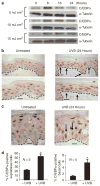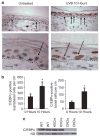C/EBPα expression is downregulated in human nonmelanoma skin cancers and inactivation of C/EBPα confers susceptibility to UVB-induced skin squamous cell carcinomas
- PMID: 21346772
- PMCID: PMC3418815
- DOI: 10.1038/jid.2011.31
C/EBPα expression is downregulated in human nonmelanoma skin cancers and inactivation of C/EBPα confers susceptibility to UVB-induced skin squamous cell carcinomas
Abstract
Human epidermis is routinely subjected to DNA damage induced by UVB solar radiation. Cell culture studies have revealed an unexpected role for C/EBPα (CCAAT/enhancer-binding protein-α) in the DNA damage response network, where C/EBPα is induced following UVB DNA damage, regulates the G(1) checkpoint, and diminished or ablated expression of C/EBPα results in G(1) checkpoint failure. In the current study we observed that C/EBPα is induced in normal human epidermal keratinocytes and in the epidermis of human subjects exposed to UVB radiation. The analysis of human skin precancerous and cancerous lesions (47 cases) for C/EBPα expression was conducted. Actinic keratoses, a precancerous benign skin growth and precursor to squamous cell carcinoma (SCC), expressed levels of C/EBPα similar to normal epidermis. Strikingly, all invasive SCCs no longer expressed detectable levels of C/EBPα. To determine the significance of C/EBPα in UVB-induced skin cancer, SKH-1 mice lacking epidermal C/EBPα (CKOα) were exposed to UVB. CKOα mice were highly susceptible to UVB-induced SCCs and exhibited accelerated tumor progression. CKOα mice displayed keratinocyte cell cycle checkpoint failure in vivo in response to UVB that was characterized by abnormal entry of keratinocytes into S phase. Our results demonstrate that C/EBPα is silenced in human SCC and loss of C/EBPα confers susceptibility to UVB-induced skin SCCs involving defective cell cycle arrest in response to UVB.
Conflict of interest statement
The authors state no conflict of interest.
Figures





References
-
- American Cancer Society. Cancer Facts & Figures 2008. 2008 http://www.cancer.org/Research/CancerFactsFigures/cancer-facts-figures-2008.
-
- Bennett KL, Hackanson B, Smith LT, et al. Tumor suppressor activity of CCAAT/e. Cancer Res. 2007;67:4657–64. - PubMed
-
- Bielas JH, Loeb LA. Quantification of random genomic mutations. Nat Methods. 2005;2:285–90. - PubMed
Publication types
MeSH terms
Substances
Grants and funding
LinkOut - more resources
Full Text Sources
Medical
Molecular Biology Databases
Research Materials

